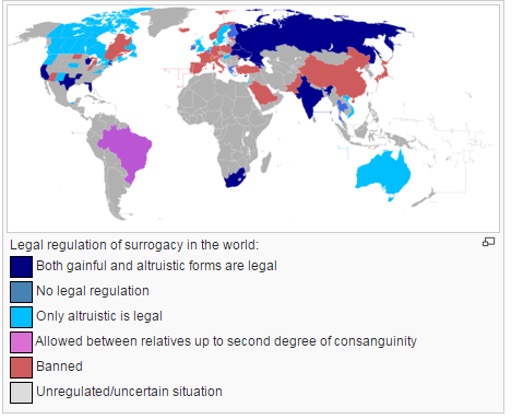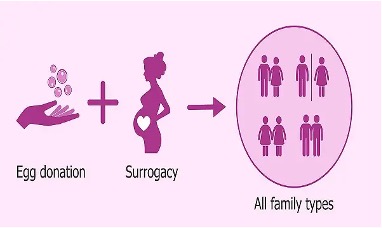Introduction
Surrogacy has recently grown into a multi-billion-dollar industry, gaining worldwide media coverage. Discussions and disputes on the morality, admissibility, and societal repercussions of surrogacy have spurred this phenomenon. People and couples all around the world are using surrogacy as a way to realise their parental goals, from same-sex couples to Hollywood celebrities. This article examines the surrogacy industry’s global expansion, illuminating its intricacies and the numerous runs of its expansion.

Global Appeal of Surrogacy
A woman carries and gives birth to a child for another person or couple through surrogacy (which has a long history). However, it has drastically changed and grown during the last few decades. There are a number of reasons why surrogacy is becoming more popular internationally:
Medical technological advancements: The introduction of Assisted Reproductive Technologies (ART), such as In Vitro Fertilisation (IVF), has given infertile couples a realistic alternative to surrogacy. These innovations have bolstered surrogacy’s success rates, making it a more desirable option.
Changing Family Dynamics: To start or grow their families, surrogacy has become one of the popular choices for different family types, including same-sex couples and single parents. A route to parenthood may not be available through conventional means, but surrogacy offers one.
Globalisation: Access to international surrogacy has increased, thanks to advancements in communication and transportation. People from nations with stringent surrogacy laws frequently look for surrogates in countries with laxer rules.
Economic considerations: Surrogacy can be a financial advantage for women in less developed nations. The number of surrogacy services available in these areas has increased with the help of this economic incentive.
Celebrity Endorsement: Notable instances in which celebrities opted for surrogacy have brought the procedure to the public’s attention. In turn, this visibility has aided in its acceptance and normalisation.

Ethical and Legal Challenges
International surrogacy’s growth has not been without controversy and difficulty:
Ethical Issues: According to detractors, surrogacy takes advantage of formerly helpless women, especially in nations with tax laws. Concerns exist over possible coercion, poor pay, and the commodification of reproductive labour.
Legal Variability: Due to the broad range of surrogacy laws worldwide, it might be a challenge to understand the intricate legal system. It may cause disagreements in court, problems with citizenship, and confusion for the intended parents.
Kid Welfare: Determining a kid’s legal parentage and citizenship after a surrogacy birth can be a difficult and drawn-out process, leaving the youngster in a potentially precarious legal situation.
Commercialization: Some contend that surrogacy’s commercialisation can put financial gain ahead of the welfare of all parties—the surrogate, the intended parents, and the child.
Regulation and control: In many nations, a lack of uniform regulations and rules can result in unethical behaviour and exploitation. International rules and agreements are becoming more and more necessary.
The global rise of surrogacy is a complex anomaly influenced by legal, moral, financial, and psychological considerations. As surrogacy continues to develop and gain popularity around the world, it necessitates a thorough and all-encompassing approach to regulation and ethics to guarantee the safety of all parties concerned and the ethical use of surrogacy on a worldwide scale.

The Moral Disputations
The central issue in current ethical discussions is surrogacy. The topics of physical autonomy, commercialisation of reproduction, and potential surrogate mother exploitation, particularly in economically underdeveloped areas, are in question. The debate about surrogacy centres on whether it enables women to make decisions about their bodies and financial prospects or whether it commodifies women’s bodies and places them under unwarranted physical and mental stress.
The Turmoil in Ukraine Drives Surrogacy Into New Markets
Prior to last year, Ukraine, which attracted foreign would-be parents with reduced rates and a friendly regulatory environment, was the second-largest surrogacy market in the world after the United States. It is essential that the intended parents are listed on the child’s birth certificate rather than the surrogate mother. But all changed when Russia invaded Ukraine completely. Reports of surrogate moms moving to bomb shelters and prospective parents attempting to enter Ukraine so they could be reunited with their surrogates immediately started to surface. The conflict drove the business into nations like neighbouring Georgia, where the rules closely resemble Ukraine. This month, the Georgia branch of the World Centre of Baby, which already has operations in Cyprus in 2022, will launch. Alongside, there has been an increase in Mexico and other regions of Latin America. Commercial surrogacy programs range between $40,000 and $50,000 in Georgia and Ukraine but between $60,000 and $70,000 in Mexico. In contrast, the average household in the US makes up to $120,000.
An Opportunity for Women to Make Money
The market for surrogates has increased as a result of the global economic boom, with Facebook groups and agency advertisements luring women with the promise of big salaries. Concerns have been expressed about the industry’s attraction to women, not the least of which is the frequently significant pay gap between agency fees and surrogates’ actual earnings. A surrogate may earn less than one-fourth of the tens of thousands of dollars that intended parents are expected to pay.
Ethical Issues and Exploitation Dangers
Commercial surrogacy is fraught with serious ethical problems as well; opponents claim that the field exploits weak women. Having at least one kid and being either widowed or unmarried are requirements for many agencies, for example, as is the requirement that prospective surrogates have at least one child. The purpose, according to the agencies, is to show that a woman is mentally and physically capable of carrying a child and to prevent conflicts with her partners. Many women experienced job loss following the outbreak. They looked for widows and mothers who were in dire need of financial assistance.
A Call for Surrogacy Standards
Currently, certain nations are working to fix these issues. For instance, regulatory authorities in the United Kingdom are conducting a review to strengthen domestic surrogacy protections. The United Kingdom issued more than 400 parental orders for surrogate parents in the first three quarters of 2022. The Law Commission estimates that there may be roughly ten times as many surrogate births today as there were ten years ago. However, proponents of surrogacy say that, in addition to giving infertile couples a way to become parents, surrogacy may also empower women.

Conclusion
Surrogacy is becoming increasingly popular internationally, which reflects how modern families are evolving, the impact of medical progress, and the accessibility of assisted reproductive technologies everywhere. While surrogacy has helped many people find pleasure and fulfilment, it has also generated ethical, legal, and social issues. A major issue is finding a way to reconcile honouring the many cultural and legal contexts found in various nations with the rights and well-being of intended parents, surrogates, and children. In order to maintain surrogacy as a viable choice for individuals who seek it and to protect the rights and dignity of all parties involved, there is a need for continual international cooperation and the establishment of ethical principles.
Written by – Sneha Jain
Edited by – Archi Agarwal




